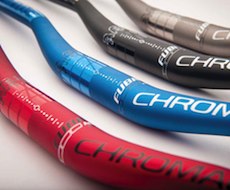
MTB handlebars may seem a fairly innocuous component to upgrade, but sometimes a change to the cockpit can alter the way your bike rides for the better.
Improved control, weight, durability and altering the 'feel' to be more inline with your riding style are all gains to be made when upgrading this part.
Have a look at the BikeRoar listing of available MTB bars here.
Here are 5 incentives to have a look at swapping out your old handlebars for something new:
1: Alloy / steel to carbon
First decision when upgrading any bike component: does it come in carbon fibre? A great way to bling your MTB is by upgrading those tired old alloy bars with a shiny carbon fibre job. Carbon can be considerably lighter, (though not always), so is the number one choice for the weight weenie. It also has the "compliance" properties we hear so much about regarding this material.
TECH: You hear the term "compliance" a lot, usually regarding road bikes, but I have also noticed the term slipping into MTB circles to describe carbon fibre hardtails. Compliance is used to describe carbon fibre's stiff yet forgiving nature. By altering the shape, direction and structure of the carbon fibre, manufacturers can keep very high levels of stiffness and strength, but also add a capacity to absorb or dampen vibration. For this reason, carbon bars can absorb vibration and impact better than most alloy bar equivalents, resulting in a slightly more comfortable ride.
The only downsides are the price, which can be high to very high, and the longevity. Carbon is not so good coping with lateral clamping forces and impacts and should be checked regularly for signs of damage and fatigue.
In saying that, a quality carbon bar is a beautiful thing, great for weight weenies, TB racers, or anyone just wanting to add an extra bit of class to their ride.

2: Flat to rise, rise to flat
The riser bar is the standard bar equipped on most mountain bikes. It has all-round properties that make it perfect for nearly every MTB discipline. For general trail and gravity riding the riser bar is the best choice, as it offers excellent leverage, a well setup body/hand position and spot-on control. Different types are available, and these will be recognised by the amount of rise and sweep.
For an aggressive XC rig, you may want to consider upgrading to a flat bar which has 0 rise, although it may have a slight sweep back to aid control and comfort.
These bars are the choice for a fast steering race bike, although for general trail riding they may result in a "nervous" feel. The flat bar is for speed and tight, snappy handling in technical singletrack.
A technical rundown on the different rise and sweep measurements is beyond the scope of this article, but will be covered later. Keep checking BikeRoar or drop us a question in the comments.
3: Width
Width also has a dramatic effect on bike control. Downhill and freeride MTBs have the widest bars (and short stems) to allow the rider greater control at speed. It helps to muscle a big tyre into the corners aggressively when you have the extra leverage of a widely spaced grip.
Similarly if you want the more nimble performance of an XC bike than look to narrowing your bars down. Some fast, tight cross country tracks have obstacles like narrow trees to manoeuvre between and narrow bars make this a lot easier. Narrow bars also allow you to tuck in and get out of the wind like a road bike rider.

TIP: Bar width is a personal thing. Down hill and freeride bars can be 700-800mm wide, while bars for cross country will be in the 600-700mm range. One idea is to buy a wider bar and cut it down (careful, go too far and oh, oh!) till it is right for you.
4: Weight
This is related to upgrading to a carbon bar which will generally result in a lighter weight option. It is worthwhile though, comparing how much weight you will lose against how much extra money you may have to spend. Cheap carbon can be more expensive than alloy but not necessarily very much lighter.
Reducing weight on the front end can make steering easier and lighter. This is important on all-day or endurance rides or races, as you want to reduce fatigue wherever possible.
If you're shooting for a sub 10kg MTB, lightweight carbon bars will be your best bet.
 5: Bling
5: Bling
Everyone loves bling! If you are keen to avoid carbon fibre perhaps an anodized alloy bar would be just the thing to soup up your rig. Anodized alloy resists scratches and obvious wear much better than anything painted and so is perfect for your MTB.
If you want something really bomb proof, you may be able to find a handle bar made from Cromoly. The ultimate in strength verses weight.


